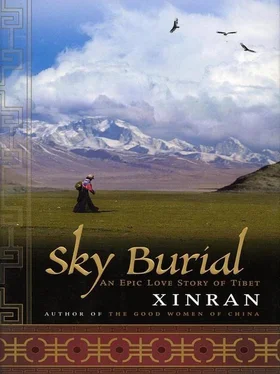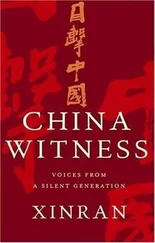WHEN THEY arrived at Wendugongba, Wen and Pad waited outside because women were not permitted within the precincts of the monastery. The lama who received the men told Zawang that his brother was absent from the monastery, accompanying the abbot on an administrative visit around the region. However, all travelers were welcome guests at the monastery and he and his companions could await his return at the monastery’s guesthouse nearby.
The accommodation separated men and women. Wen and Pad were led to a simple mud-brick room, with an adjoining room for their animals. The doors and windows were made of oiled felt rugs nailed into wooden frames. The room was about fifteen meters square, the main wall hung with a long religious scroll. Beneath this were some simple wooden shelves. Two single beds were the only other furniture, except for two rush cushions on the floor for meditation and reading the scriptures.
Wen almost cried when she saw the room: it had been so long since she had slept somewhere with walls that she felt quite overwhelmed. She sat on the bed and savored the privacy it offered. To share a sleeping space with only one other woman was a huge luxury.
When she examined the few objects on the wooden shelves, she was astonished to find that several of them came from China. There was a plastic bag from the famous Rongbaozhai art-materials shop in Beijing and glazed paper made in Chengdu; there was even a torch made in Shanghai. Seeing these things brought more tears to her eyes: other than her own meager belongings, she hadn’t seen a single object with a Chinese connection for years. Chinese people must have brought their possessions to this empty room. She sensed she was drawing closer to the answer she sought.
At suppertime, a lama told them that a huge ceremony called the Dharmaraja would take place at the monastery in a few days’ time. The lamas would be practicing in the open courtyard in front of the entrance to the monastery and their rehearsals must not be disturbed. The three Tibetans felt blessed that such an important religious festival would be taking place while they were at the monastery. Pad explained to Wen that whoever had their head touched by the Dharmaraja would attain peace, safety, and their heart’s desire.
THAT EVENING, before the men and women separated to go to their separate quarters, Wen asked Ge’er if it would be possible to make inquiries about Kejun the next day at the monastery. Ge’er promised to talk to the lamas in the morning.
Before she fell asleep, Wen inlaid yet another line of text in her book: “Jun, today I have seen Chinese writing again. This must be a sign from you. My dearest husband, tonight please tell me in my dreams where you are.” But Wen lay awake all night, unvisited by dreams.
The next day, a lama came especially to let Wen know that they would inform the whole monastery of her search at the hour for scripture debate, and that they would also ask the visitors and sightseers who attended the forthcoming Dharmaraja festival.
AT DAWN on the day of the ceremony, several large gongs rang, waking Wen. Looking out of her window, she saw a figure standing silhouetted on the roof of the monastery: a lama dressed in a purple robe, banging a huge bronze gong. For the next two hours, the lamas could be heard chanting the scriptures, the sound rising and falling through the buildings. Wen thought of Saierbao, Zhuoma, and Ni, three pious women who had spent their lives praying and reciting the scriptures.
Just before the ceremony was about to begin, a boy lama came running over to the guesthouse to escort them to the monastery’s courtyard, situated in front of the ornate entrance to the monastery. He arranged for them to sit on the ground in the front row, which was the best position from which to receive the Dharmaraja’s blessing.
This was the first time Wen had watched a Tibetan religious ceremony from such close range. She stared, entranced, at the sea of banners. In front of the monastery doors, eight long horns were propped up, flanked by lamas wearing tall, crested helmets. Lamas in costume were forming themselves into a great square. Suddenly, a line of lamas dressed in robes of red and gold sounded their glittering trumpets. A group of performers, looking rather like Peking Opera actors, came striding out of the monastery building. “These are the lamas who are going to perform the dance,” Pad whispered to Wen. “When the Dharmaraja passes, don’t forget to step forward with me so he can touch your head.”
It was an incredible spectacle. Dozens of dancers, dressed in bright colors and wearing headdresses that represented horses or cattle, filled the courtyard. Lamas chanted sutras and blew on copper horns and conch shells. Blasts from the longer horns set the pace of the dance, as the Dharmaraja went around the spectators bestowing blessings. Wen had no idea what the dance meant, but she was exhilarated by what she saw.
She turned to survey the crowd to see if the other spectators were similarly uplifted by watching this extraordinary communion between the human and spirit worlds. To her astonishment, she noticed a number of Chinese faces. Her heart missed a beat to see the familiar blue, black, and gray of their clothing among the brightly colored Tibetan clothes. Although her instinct told her to push her way through the throng toward them, she was overcome by the gulf that now separated her from the world she had left. She had not uttered a Chinese word out loud for many years. Would she even be able to speak to them?
She made her way cautiously through the sea of people, trying to find a group of Chinese people who looked approachable. When she spotted a woman of about her own age, animatedly discussing the ceremony with her friends, she went up to her and bowed her head.
“Excuse me,” she said. “Can I ask you a question?”
The words felt strange in her mouth.
“You speak Chinese?” the woman asked, clearly surprised that someone who looked like a Tibetan nomad could speak her language.
“I am Chinese,” Wen said sadly. “But I have been in Tibet since 1958.”
How could she possibly begin to explain what had happened to her?
The woman and her friends were amazed. They overwhelmed her with a torrent of questions.
“How did you get here? Were you a prisoner?”
“When did you learn to speak Tibetan?”
“Do you live with Tibetans? How do they treat you?”
“Is your family here?”
One of the men in the group suggested that they find a quiet place to talk, away from the crowds.
“We have many things to ask you,” he said, “but I sense that you also have questions that you want to ask. Let’s go and sit on that hillside over there.”

THE SMALL group of people assembled themselves in a circle on the hillside. Besides the man, who Wen learned was originally from Hubei and worked in agriculture, there was a young man and woman from Henan who worked as technicians in a Tibetan hospital and an older woman from Sichuan who was a teacher. They all had different reasons for coming to live in Tibet. The young people told her that they had taken advantage of the financial incentives offered by the Chinese government to move to Tibet; there were many jobs to be found here. The older man said he had come to Tibet in the 1970s when agricultural workers from Hubei were in demand because it was preferable to the difficult political situation in China. The woman said that, because Sichuan was close to the Tibetan border, she had moved to Tibet in the 1960s to “support the border regions.”
It took some time for Wen to explain to them how she came to be dressed in Tibetan clothing, her face weather-beaten, her hands rough. When she had finished, the group was utterly silent. They looked at her in disbelief.
Читать дальше













